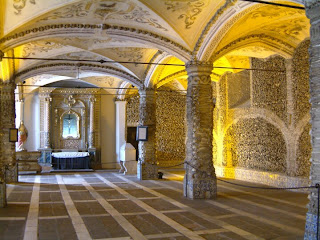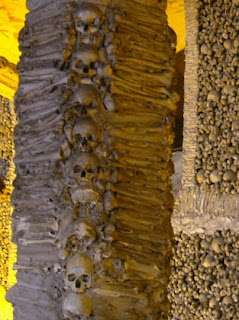 Click the image for full size
Click the image for full size
By: Janet Brennan
Evora’s Chapel
One of the largest Chapels of Bones is in the Portuguese city of Evora, at the Church of St. Francis. Built by Franciscan monks between 1460 and 1510, the chapel is constructed of the bones of some 5,000 people. Tourists to the site find the macabre mood is set immediately with the inscription above the entrance that carries a ghoulish message to visitors: “We bones that are here are waiting for yours.” Inside the dimly lit chapel, it takes a moment to realize that the interior walls and the pillars supporting the arched ceiling are composed entirely of neatly stacked leg bones, arm bones, and skulls. Once the shock of this realization subsides, visitors begin to appreciate the almost comical sight of hundreds of skulls lined up, jaw-to-cranium, to make borders around the sections of vaulted ceiling. The artwork on the ceiling continues the combination of weirdness and whimsy: curly-haired cherubs hover above painted skulls-and-crossbones, and scythes are interspersed with elegant flowers. A statue of Jesus and an ornate, gilded altar are overshadowed by the chapel’s most gruesome decoration: two desiccated corpses hanging on a side wall. The bodies of a man and a small child are now several hundred years old, but there are still skin and shreds of clothing clinging to their pathetic frames. According to a tour guide, the man was a wife abuser, and his little son was just as disrespectful to his mother. The man finally beat his wife to death, but before she succumbed, she put a curse on her husband and child. She declared that they would soon follow her in death, but, since they were so evil, even Hell would not accept them. As she predicted, the pair soon died. When they were to be buried, the ground mysteriously turned hard as a rock, and their graves could not be dug. So, the monks took their bodies and put them on permanent display in the chapel, as a warning to other wife abusers and bad children. Whether true or not, the legend shows the Franciscan monks to have been feminists before their time. In recognition of this, local women engaged to be married cut off their hair and place the braids at the chapel entrance, making a symbolic sacrifice of their girlhood in supplication for a happy marriage. This custom continues today, with several fresh braids on display.
Wednesday, May 28, 2008
Chapels of Bones
Labels: Human Phenomena
Posted by besar at 8:23 PM
Subscribe to:
Post Comments (Atom)


0 comments:
Post a Comment